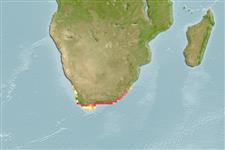Elasmobranchii (haaien en roggen) (sharks and rays) >
Carcharhiniformes (Ground sharks) >
Triakidae (Houndsharks) > Triakinae
Etymology: Triakis: tri-, from tres (L.), three; akis (Gr.), point, referring to each tooth consisting of one large central cusp flanked on by both sides by a small cusplet. (See ETYFish); megalopterus: mega-, from megas (Gr.), large; pterus (Gr.), fin, referring to its broad, large fins. (See ETYFish).
More on author: Smith.
Environment: milieu / climate zone / depth range / distribution range
Ecologie
marien demersaal; diepte 1 - 50 m (Ref. 5578). Subtropical; 30°S - 36°S
Southeast Atlantic: Namibia to Coffee Bay, South Africa.
Lengte bij maturiteit / Grootte / Gewicht / Leeftijd
Maturity: Lm 145.0, range 140 - 150 cm
Max length : 142 cm TL mannelijk / geslacht onbekend; (Ref. 244); 174.0 cm TL (female); max. gepubliceerd gewicht: 20.0 kg (Ref. 5485)
Dorsale stekels (totaal): 0; Dorsale zachte stralen (totaal): 0; Anale stekels 0; Anale zachte stralen: 0. Blunt snout and a large mouth with small pointed teeth; caudal peduncle short and heavy (Ref. 5578). Grey with numerous black spots which may be sparse or absent in some specimens; new born pups with fewer black spots compared to adults (Ref. 5485); white below (Ref. 5578).
Occurs off sandy beaches, rocky shores and in shallow bays (Ref. 5578). Feeds on crabs, lobsters, bony fish and small sharks (Ref. 5578). Ovoviviparous (Ref. 50449). Forms schools in summer (Ref. 244). Hardy and keeps well in captivity (Ref. 244). Commonly caught by rock and surf sports anglers but not eaten much (Ref. 244). Meat is dried into shark 'biltong' or jerky which commands a relatively high price (Ref. 244). Attains 160 cm, TL (Ref. 36731).
Ovoviviparous, embryos feed solely on yolk (Ref. 50449), with 6 to 12 young in a litter (Ref. 244). 30-32 cm at birth (Ref. 244).
Compagno, L.J.V., 1984. FAO Species Catalogue. Vol. 4. Sharks of the world. An annotated and illustrated catalogue of shark species known to date. Part 2 - Carcharhiniformes. FAO Fish. Synop. 125(4/2):251-655. Rome: FAO. (Ref. 244)
Status op de Rode Lijst van het IUCN (Ref. 130435)
Gevaar voor de mens
Harmless
Gebruik door de mens
Visserij: van minder commercieel belang; sportvis: ja; Aquarium: Publieke aquaria
Meer informatie
Leeftijd/GrootteGroeiLengte-gewichtLengte-lengteLengtefrequentiesMorfometrieMorfologieLarvenLarvale populatiedynamiekRekruteringAbundantieBRUVS
ReferentiesAquacultuurAquacultuurprofielKweeklijnenGeneticaElectrophoresesErfelijkheidZiektesVerwerkingNutrientsMassaconversie
Tools
Speciale rapporten
Download XML
Internetbronnen
Estimates based on models
Preferred temperature (Ref.
123201): 15.8 - 22.4, mean 19.3 °C (based on 26 cells).
Fylogenetische diversiteitsindex (Ref.
82804): PD
50 = 0.5312 [Uniqueness, from 0.5 = low to 2.0 = high].
Bayesian length-weight: a=0.00240 (0.00110 - 0.00521), b=3.14 (2.96 - 3.32), in cm total length, based on LWR estimates for this (Sub)family-body shape (Ref.
93245).
Trofisch niveau (Ref.
69278): 4.0 ±0.5 se; based on diet studies.
Weerstandsvermogen (Ref.
120179): Zeer laag, minimale populatieverdubbelingstijd meer dan 14 jaar (Fec=6).
Fishing Vulnerability (Ref.
59153): Very high vulnerability (90 of 100).
